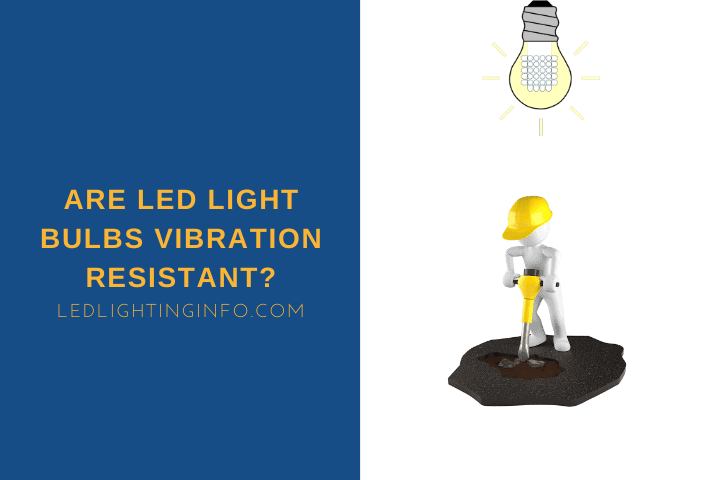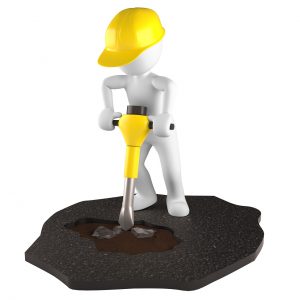Let’s face it, vibrations are everywhere. Whether through an angsty teen slamming doors or construction workers drilling a nearby road, none of the items in your home are entirely safe from vibrations.
In the past, this has been a massive problem for light bulbs. Even small judders would cause filaments to snap and glass to shatter. So do modern LEDs suffer from the same fragilities?
LED bulbs are somewhat vibration resistant. Unlike conventional bulbs that use fragile filaments to generate light, LEDs produce light using a robust semiconductor. The vibration will rarely cause LEDs to blow, but it will speed up the lumen degradation rate.
They may be a fact of life, but in some scenarios, the vibration level is much higher than usual. Think of oil rigs, for example. In these situations, people may be rendered unsafe without adequate lighting, so choosing a resilient bulb is imperative.
Keep reading if you want to learn about the full impact of vibration on LED bulbs and how LEDs compare to ‘rough service’ incandescent bulbs.
Can Vibration Damage LED Bulbs?
Let’s start by looking at the extent of the damage caused by vibration on LED bulbs.
As solid-state light sources, LEDs have high vibration resistance. This is because LED semiconductors are made from a metal compound, usually gallium, which is relatively sturdy. But LEDs are not entirely immune, there are three ways that vibration can damage an LED bulb.
Firstly, excess vibration can crack or shatter the glass bulb surrounding the diode. This is a common issue for all bulbs since glass is brittle. With conventional bulbs, cracked glass will cause the filament to oxidize and stop working.
In contrast, when an LED bulb breaks, the diode itself will continue emitting light. The crack does not impact the performance of the LED; it merely has aesthetic implications. To counter this, most modern LED bulbs are made from shatter-resistant glass.
The second consequence of vibration relates to the LED’s inner components. LED drivers contain several wires and connections. Excess vibration will loosen these connections, which in turn will cause flickering. This damage is not permanent, nevertheless, as connections can be re-established using solder.
Thirdly, Edison-style LED bulbs will respond to vibration the same way that conventional filament bulbs do. That is, the filament will snap.
Of course, LED filaments do not generate light using heat. So, fortunately, they are likely to be more robust than conventional filaments.
How Much Vibration Can LEDs Withstand?
With that in mind, it’s worth setting out precisely how much vibration LEDs can withstand.
The answer depends on a variety of factors. The frequency of the vibration, the LEDs distance from the vibration, the quality of the LED, and whether exposure to the vibration is intermittent or continuous.
Jayalakshmi Paladugu wrote a thesis on the effect of mechanical vibrations on LED luminaires. For the research, Jayalakshmi compared the performance of a 14W, 720 lumen PAR30 LED bulb to two types of CFLs.
While the results showed that 24-hour vibration affects the intensity of LED bulbs, this relationship is not linear. For instance, when an LED is 34.74 inches away from a 15Hz vibration, the intensity of the bulb decreases by 25%. But at 39.74 inches, the bulb performs the same as when there is no vibration.
So it goes without saying that there are no hard and fast rules. It’s clear that vibration impacts LED performance, but more testing in this area is needed.
| Frequency (Hz) | 30.74 inches | 34.74 inches | 39.74 inches | |||
|---|---|---|---|---|---|---|
| Intensity | Lumen | Intensity | Lumen | Intensity | Lumen | |
| 5 | +15 | +16 | +11 | -9 | -9 | -10 |
| 10 | +3 | +6 | -15 | -15 | -6 | -2 |
| 15 | +5 | +5 | -25 | -26 | NO CHANGE | NO CHANGE |
Source: Jayalakshmi Paladugu
Is LED Bulbs Better Alternative Than Rough Service Incandescent Bulbs?
First demonstrated in 1962, LEDs are a relatively modern technology. But things like demolition and natural disasters have been happening for centuries. What type of lighting was used in these volatile scenarios before LEDs?
Rough service (RS) bulbs were introduced as a sturdier alternative to standard incandescents. Their fragile filaments are replaced with thicker, heavier filaments that are designed to withstand vibration. Most RS bulbs also have a silicone coating that renders them shatter-proof too.
Additionally, RS bulbs must comply with vibration checks under BS En 60068-2-6:2008. This test sets out that:
“The luminaire must be fastened to a vibration generator. The severity of the vibration is:
- Duration: 30 min,
- Amplitude: 0.35mm
- Frequency range: 10Hz, 55Hz, 100Hz
- Sweep rate: approximately one octave per minute
After the test, the luminaire shall have no loosened parts.”
Although at a glance it may seem like RS bulbs are a well-tested solution, this isn’t the full picture. Due to their heavier filament, the recommended voltage for RS bulbs is 130v. But the standard voltage supplied to American households is 120v.
10 volts may seem trivial, but a decrease in voltage equates to a reduction in light output. This isn’t a problem for LEDs, as they operate at a very low voltage. So if you need vibration-resistant bulbs in a high accuracy situation, RS bulbs may not be satisfactory.
LED Use In Vibrating Environment
All in all, LEDs are the best type of lighting for unstable environments. Not only are they durable, but they’re long-lasting, don’t require heat, and start-up immediately.
If you’re still uncertain, it may be useful to talk through some specific examples.
Garage Doors Openers
The lights used in garage door openers are subject to intermittent but intense waves of vibration. The doors are opened and closed.
Manufacturers such as Genie have produced bulbs specifically for this scenario.
Their 10 watt, 800 lumen LED bulb (Amazon) is vibration-resistant, shatter-proof, and engineered so that it doesn’t interfere with the signal of the garage remote.
LEDs are also beneficial in this environment because they are not affected by frequent cycling.
In other words, being turned on and off for short periods does not impact their life span.
Using During Renovation
The same is true when it comes to lighting on building sites or during home renovations. With frequent drilling, hammering, and banging, these areas require incredibly sturdy work tools.
Unlike traditional lights that rely on delicate glass bulbs, LED chips can be surrounded in any translucent material – from shatter-proof polycarbonate to durable epoxy resin. In this sense, LEDs are likely to save money since they will need replacing much less.
Similarly, as I’ve already mentioned, LEDs will continue to work even if their surrounding bulb is chipped. So if the fixture is damaged, it’s no big deal.
Final Words
The first law of thermodynamics states that energy cannot be created or destroyed. It can only be transferred or changed from one form to another.
So, unfortunately, vibrations are something you just have to put up with.
Thankfully, the widespread introduction of LEDs means that you no longer have to worry about your bulbs shattering every time a helicopter flies over your home.
While more research is needed, LEDs are as good as it gets in terms of vibration-resistant lighting.
Do you use LEDs in high-vibration environments, or are you still using rough service incandescents? Are you planning to make the switch anytime soon?
I’d love to hear your thoughts, so leave a comment down below!
Looking for an LED bulb but not sure what type you need?
Check out my free bulb picker and select the right bulb within few clicks.



